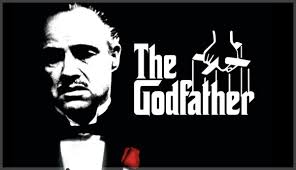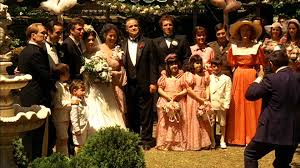The Godfather (Part I)
by Zach C.
WARNING: This post contains spoilers.
Well readers, it’s been quite a while since my last multi-part blog. In fact, it’s been over two years. The last time I blogged about a film in a multi-part sequence was with François Truffaut’s “Day for Night” (La Nuit Américaine), which I’m sure almost nobody read!
In any case, we’re back to multi-part blogging with a two-part piece for Francis Ford Coppola’s The Godfather and The Godfather, Part II. In my book, Part III doesn’t exist and probably should never have been made, so I will not be treating it here. I digress from my focus, however, which is….at the moment….the first Godfather movie.
There is no doubt in my mind that Coppola’s 1972 hit is easily one of the greatest films ever made. I think few people can argue against this statement for a variety of reasons. Above all things, the posterity that it has achieved from its worldwide recognition sets it apart from almost any other film. There are so many staples from The Godfather that anyone could recognize without having even seen the film in full.
One thing that intrigues me is that the film has reached an acclaim that was never imaginable while it was being filmed in 1971. By all accounts, Coppola, a brilliantly talented but evidently stress-centric director, was challenged by the production. He, along with the producers and his colleagues, faced a hurdle of difficulties, but most especially with pleasing executives based on acting and writing choices. Despite these difficulties, what they ultimately achieved was 175 minutes of pure excellence.
A film that traces the development of the New York-based Corleone family, one of the fictional five families in the New York mafia, over a period of 10 years (roughly 1945-1955), The Godfather explores a changing cycle of friends, enemies, trust, mistrust, and so much more.
The Godfather has a classic opening if there ever was one. The slow, elevating music and fade from black after the iconic Paramount logo vanishes allows for the scene to open on a speech about America. America, which remains at the core of the film series’ themes, guides the viewers into the setting of the home of Don Vito Corleone (Marlon Brando) on the day of his daughter’s wedding. Since no Sicilian can refuse requests on his daughter’s wedding day, Don Corleone is seen negotiating with friends alongside his fellow mafioso, evidently achieving the American Dream that he sought years before.
The audience is quickly introduced to Don Corleone’s family and friends, many of whom are memorable and entertaining. His adopted son, Tom Hagen (Robert Duvall), the consigliere or family lawyer, his eldest son, Santino “Sonny” (James Caan), the underboss, his dimwitted son, Fredo (John Cazale), and his beloved youngest son, Michael (Al Pacino), who has recently returned as a hero of WWII alongside his new girlfriend Kay Adams (Diane Keaton) make up the opening introduction of the family. His only daughter, Connie (the lackluster Talia Shire) and her jerk of a husband, Carlo (Gianni Russo) are the wedding that begins the film. His wife, Carmela (Morgana King) is also introduced, but remains a minor part of the entire film series.
As the wedding continues and the Don receives his guests, the audience is introduced to many set-ups for the remainder of the film. These include the opening scene with Bonasera the undertaker’s request for the Don to kill the two boys who beat his daughter, the Don’s godson Johnny Fontane requesting that he negotiate with a film producer for Johnny to star in a major motion picture, and the Don’s ties with Luca Brasi which result in nothing but danger to his family.
The script brilliantly allows for a host of foreshadowing because of these sequences. Aside from the long labeled idea that oranges symbolize death in the film, which I definitely see as true, many of these opening lines foreshadow the danger and bloodshed that results.
Coppola and Puzo’s script, based on the novel of the same name by Mario Puzo, really is brilliant and delivers the theme that it intends. Between the dialogue, multiple subplots, and the way everything ultimately ties together, the film is nothing short of excellent because of this script and Coppola’s masterful direction.
Coppola really does take the idea of directing to a new level. It is obvious that he collaborated extensively with a talented production team. From the lavish sets to the detailed photography and dark shots to the great costumes which simply capture the time and place, Coppola knew what he was doing even if he didn’t think so. What really sets the film apart from others is the performances, which we owe in part to Coppola’s great casting and directing skills. Puzo’s awesome characters certainly do help.
Brando’s portrayal of Don Vito Corleone is pure magic. He is perfect in every sense of the word. Brando, a well-known Method actor who really took to portraying his roles in a passionate manner, is so unbelievably realistic in his characterization that you cannot help but think he is Italian. His gruff voice, spot-on mannerisms, and excellent ability to capture an aging man’s struggle with life, work, and family are so creative and clever that I cannot imagine anyone else playing the Don at this particular stage than Brando. An Oscar winner for Best Actor for this role, Brando deserved every bit of that statue. Though his performance admittedly makes up only about a third of the film, making many question his stance as a lead actor, he truly does lead the cast as the family patriarch whose motives guide them throughout the film.
Brando also has many pieces of great dialogue, but it is his immediate chemistry with Al Pacino’s Michael that makes the film such an enjoyment. Obviously favoring Michael, some of the best scenes in the film are between these two actors, including the one at the hospital, when the Don first arrives back home, and the scene in the garden where the Don laments the lack of time.
Pacino is fantastic, too. If any one performance captures the significance of change throughout one single film, then it is Pacino’s portrayal of Michael. Beginning as perhaps the least Corleone family oriented whose intentions remain to please Kay and be reserved from the criminal efforts of his father and brothers, Pacino shifts completely when he realizes the harm that the law does on his father’s life. This shift to violence, a desire for revenge, and above all things, an ability to lead dynamically, takes him from the quiet, semi-shy Michael that we meet at the beginning, to the passionate, dangerous Michael at the end of the picture. Transformation has rarely applied to a character as much as it does to Pacino’s Michael, without even examining his changes in Part II. Another instance where the “nothing short of brilliant” expression undoubtedly applies. Pacino, who boycotted the 1973 Oscars because he was nominated as a Supporting Actor, should have been nominated alongside Brando in the lead Actor category. Does Brando’s performance still edge him out? I contend yes, but ever so slightly. Pacino develops more in Part II and delivers an even stronger performance of the ever-changing Michael whose transition from quiet to dangerous is never more evident than the iconic final shot of Part II.
The supporting cast of the picture is another part of what makes it so special. James Caan’s take on the hotheaded Sonny is both hilarious and heartbreaking, but he is easily among the most fun to watch. Robert Duvall’s portrayal of the business-like Tom, whose relaxed nature but pervasive desire for family success allows him to be a complex character, is nuanced, but effective. John Cazale’s characterization of the weak but aspiring Fredo is vivacious, but not nearly as developed and amazing as Part II allows. Diane Keaton, whose ability to place Kay vis-a-vis Michael as a transformative figure with a desire for change that only allows a betterment to her family and a push away from the mafia, is complex but intriguing.
It is the work of one particular supporting performer that I can’t help but mention as perhaps the most effective. Richard Castellano, who plays caporegime Peter Clemenza, is enjoyable in every possible way. Between his ability to capture the comic relief nature of Clemenza through his hilarious dialogue and mannerisms, to the seriousness he employs in his love for the Don and the family, to his intense involvement in the plot, Castellano is a thrill to watch and delivers a performance that is effective in multiple means: it can be hilarious, nuanced, vivacious, and intriguing, something that remains difficult, but can, in few instances, be done. It is a shame that he could not appear in Part II (see next post for more information) and that his performance was not recognized as he may very well be the Best Supporting Actor of Part I, with Caan closely following.
So many other great performers make up the more minor supporting roles. From Abe Vigoda’s Sal Tessio to John Marley’s Jack Woltz to Al Lettieri’s Sollozzo, the cast really is superb and each captures their role well. The only exception to this equation is Talia Shire and Gianni Russo, who play Connie and Carlo Rizzi.
As much as Russo delivers, he is so unlikable that you can’t help but cringe when he is on screen. Shire, who was only cast because she was Coppola’s sister, is lackluster per usual and completely unenjoyable to watch. The only scene I dislike in the film is their fight scene. Between Russo’s macho, jerky attitude and Shire’s whiny, overdramatic response to Carlo, the scene is terrible and their performances certainly do not benefit because of it. Luckily, neither of them are in much of the film. I can see why Coppola didn’t originally write this scene. It was only when one executive said more direct violence was needed that he responded with this.
Simply put, the film itself is iconic. From the dialogue to the direction to the aesthetics to the performances to the famous music, it is a gem to cinema that cannot go unnoticed as phenomenal.
Stay tuned for more about the saga with my post on Part II. This piece, which may result in a third post about how iconic the two films are as a whole, will review Part II and the continued story of the Corleones, while also bookending the posterity that continues to dominate after Part II.







